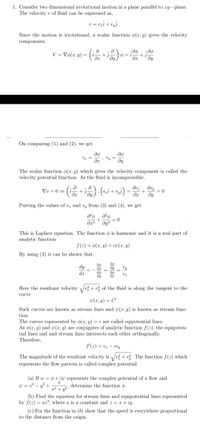
Advanced Engineering Mathematics
10th Edition
ISBN: 9780470458365
Author: Erwin Kreyszig
Publisher: Wiley, John & Sons, Incorporated
expand_more
expand_more
format_list_bulleted
Concept explainers
Question
1.

Transcribed Image Text:1. Consider two dimensional irrotational motion in a plane parallel to xy - plane.
The velocity v of fluid can be expressed as,
Vại + vyj
V =
Since the motion is irrotational, a scalar function ø(x, y) gives the velocity
components.
V= φ(7, ) -
+j
= 1
Əx
ду
dy
On comparing (1) and (2), we get
Vr
Vy
dy
The scalar function (x, y) which gives the velocity component is called the
velocity potential function. As the fluid is incompressible,
Vv = 0 →
dy
Vgi + Vyj
dy
dx
Putting the values of
and
Vy
from (3) and (4), we get
Vx
dy?
This is Laplace equation. The function o is harmonic and it is a real part of
analytic function
f(2) = ¢(x, y) + inp (x, y)
By using (3) it can be shown that,
dy
Vy
ie
Vx
dx
dy
Here the resultant velocity
v? + v? of the fluid is along the tangent to the
curve
p(x, y) = C'
Such curves are known as stream lines and (x, y) is known as stream func-
tion.
The curves represented by ø(x, y)
As ø(x, y) and Þ(x, y) are conjugates of analytic function f(z), the equipoten-
tial lines and and stream lines intersects each other orthogonally.
Therefore,
= c are called eqipotential lines.
f'(2) = vn – ivy
The magnitude of the resultant velocity is /v? + v3. The function f(2) which
V
represents the flow pattern is called complex potential.
(а) If w %3
p = x² – y? +
O + ip represents the complex potential of a flow and
determine the function o.
x2 + y2'
(b) Find the equation for stream lines and equipotential lines represented
by f(z) = az², where a is a constant and z = x + iy.
(c) For the function in (b) show that the speed is everywhere proportional
to the distance from the origin.
||
Expert Solution
This question has been solved!
Explore an expertly crafted, step-by-step solution for a thorough understanding of key concepts.
This is a popular solution
Trending nowThis is a popular solution!
Step by stepSolved in 4 steps

Knowledge Booster
Learn more about
Need a deep-dive on the concept behind this application? Look no further. Learn more about this topic, advanced-math and related others by exploring similar questions and additional content below.Similar questions
Recommended textbooks for you
 Advanced Engineering MathematicsAdvanced MathISBN:9780470458365Author:Erwin KreyszigPublisher:Wiley, John & Sons, Incorporated
Advanced Engineering MathematicsAdvanced MathISBN:9780470458365Author:Erwin KreyszigPublisher:Wiley, John & Sons, Incorporated Numerical Methods for EngineersAdvanced MathISBN:9780073397924Author:Steven C. Chapra Dr., Raymond P. CanalePublisher:McGraw-Hill Education
Numerical Methods for EngineersAdvanced MathISBN:9780073397924Author:Steven C. Chapra Dr., Raymond P. CanalePublisher:McGraw-Hill Education Introductory Mathematics for Engineering Applicat...Advanced MathISBN:9781118141809Author:Nathan KlingbeilPublisher:WILEY
Introductory Mathematics for Engineering Applicat...Advanced MathISBN:9781118141809Author:Nathan KlingbeilPublisher:WILEY Mathematics For Machine TechnologyAdvanced MathISBN:9781337798310Author:Peterson, John.Publisher:Cengage Learning,
Mathematics For Machine TechnologyAdvanced MathISBN:9781337798310Author:Peterson, John.Publisher:Cengage Learning,


Advanced Engineering Mathematics
Advanced Math
ISBN:9780470458365
Author:Erwin Kreyszig
Publisher:Wiley, John & Sons, Incorporated

Numerical Methods for Engineers
Advanced Math
ISBN:9780073397924
Author:Steven C. Chapra Dr., Raymond P. Canale
Publisher:McGraw-Hill Education

Introductory Mathematics for Engineering Applicat...
Advanced Math
ISBN:9781118141809
Author:Nathan Klingbeil
Publisher:WILEY

Mathematics For Machine Technology
Advanced Math
ISBN:9781337798310
Author:Peterson, John.
Publisher:Cengage Learning,

